Vilcabamba, Ecuador: The Raw Food Valley of Longevity… or Just Hype?
Ecuador is known as a top retirement destination for Americans due to the low cost of living and ease of getting residency, but did you know that it’s also a place for raw foodists and young international families interested in a more simple, natural way of living? Some raw food friends of mine recently moved to Vilcabamba, known to many as the “Valley of Longevity,” and after years of hearing about the place (especially after Mike Adams, Matt Monarch and Angela Stokes moved there), I decided to finally go for a visit and check it out for myself.
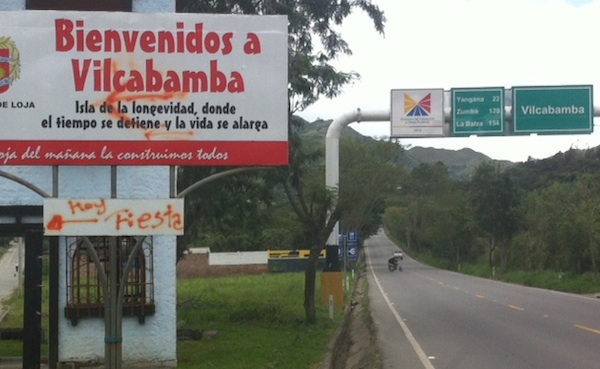
The main road entering Vilcabamba, Ecuador aka The Valley of Longevity
My boyfriend and I spent 2.5 months in Vilcabamba. We stayed at the Meditation Center in town for the first 2 weeks until we found a furnished house available for short-term rent. We found a place with gorgeous mountain views and a lot of space (2 bedrooms, an office loft, 2 full bathrooms, a large living area and kitchen) for $900 USD per month. It was less than a 10-minute walk from the center of town. This was perfect for us because we didn’t want a car and we could easily walk to town and buy whatever we needed.
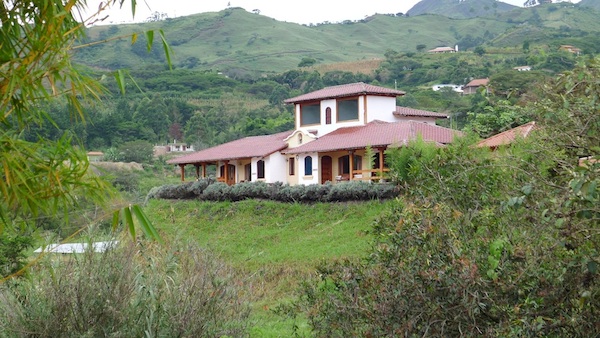
Our home for 2 months…a gorgeous mountain retreat!
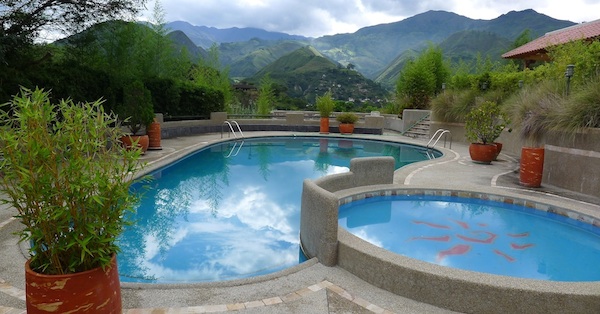
Shared pool for the small gated community…it was right next to our house

Open doors in the morning for an absolutely fantastic view of the mountains…close doors 4pm to minimize mosquitos!
Most of our time in Vilcabamba was spent preparing and focusing on the 21-day water fast that we did while there. This was our main goal in renting a house for 2 months – to take a break from all the traveling we’d done through Costa Rica, Guatemala and South America, and to have some quiet time surrounded by nature to fast and rest. What better place to do a detox than in the Valley of Longevity itself?

My first meal (pureed cucumber) after water fasting for 21 days…and NO worms! 🙂
Not to start things on the wrong side, but it has to be said: there are a lot of strange expats in Vilcabamba. You will definitely notice a weird vibe when you arrive to town. It’s a small place, everyone knows each other, and clearly you are the newcomer when you get there. We experienced a lot of long uncomfortable stares from the local “gringos”, to the point where we even googled something like “why is everyone so weird in Vilcabamba” and we actually had a good laugh when we read several travel blogs that reported having the same experience as us. There is definitely a lot of conspiracy theory talk going around about…well, just about everything. It’s almost impossible not to overhear at least one major conspiracy theory conversation per day, especially if you go the the Juice Factory, the main hang-out in the town square where all the gringos converge for a juice, smoothie, salad or the ongoing end-of-the-word discussion. I even heard a story about how the Jesus on the cross was fake, and that the real Jesus was hiding under a pyramid in Egypt… Well, who knows? It could be true!

Odd conversations aside, the Juice Factory has an awesome juice, wheatgrass and smoothie menu!
Admittedly we were a bit disappointed over the lack of normalcy in the people we met. It didn’t take us long to start keeping to ourselves, putting our energy into our preparations for fasting and trying to be friendly as much as we could. Over the course of 2.5 months, we slowly started to meet more gringos who lived further outside of town or who simply kept more to themselves as well, and by the time we were ready to leave, we did actually make some really nice and interesting friends. My best advice in experiencing Vilca is to have an open mind and be patient. There are some really cool people living there; it just might take a bit of time to find them.
People aside, there are a few key practical things that bring expats to Vilcabamba to live. One is the cheap cost of living. Most people are renting houses for about $300 per month. Our house was considered to be very expensive, but we wanted to be in a gated community for safety and security. The other main attraction is the ability to grow your own organic food because there is plenty of land and plenty of water. There are also some people looking to live in a healthy and natural healing environment with a strong sense of community, and although it’s not fully there yet, this movement in Vilcabamba is definitely growing. And many people just want to be “away from it all,” living as far away as possible from the television, media, and “Big Brother” feeling in the Western world.
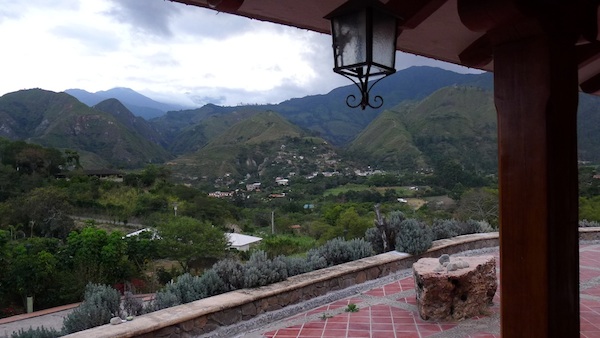
A 5-star view from our veranda, in Vilcabamba Ecuador
That’s the short of it. Here’s my full list of the Pros and Cons of Vilcabamba:
Vilcabamba, Ecuador: Pros
1. Affordable Organic Food. This was a main attraction for me. Every Saturday there is a great organic market run by Kitzia Kokopelmana where you can find all kinds of fruits, veggies and greens at fantastic prices. Of course, if you stay longer, you would have the option to grow your own. There are many expats selling non-GMO seeds and swapping crops with each other.
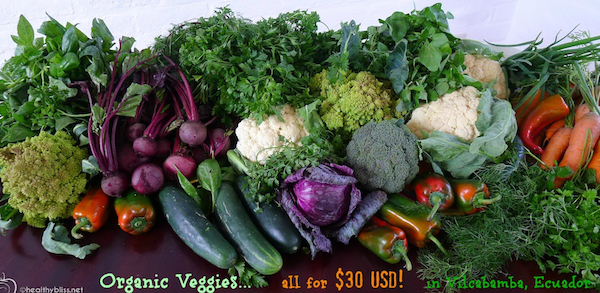
Organic produce from Kitzia’s weekly market in Vilcabamba, Ecuador
2. Affordable Housing. There are many options available. Check the notice board at the Juice Factory for postings. We also really enjoyed staying at the Meditation Center in town; it has a great outdoor kitchen and very clean rooms. Bernie, the owner, is a really nice guy and he also happens to be a real estate agent in case you are looking for a home to buy!
3. Nice locals. The Ecuadorian people are very sweet and we really enjoyed speaking our broken Spanish when we could.
4. International delivery is ok. I met some people who ordered supplements from Vitacost and everything seemed to arrive ok. I had a few packages sent from USA that arrived safely (it does take longer than other places, up to 3 weeks for airmail). This becomes very important when you actually decide to live in a place.
5. Relatively Safe. More on this below, but for the most part when comparing to Central America or Colombia, I would consider Ecuador to be much more politically stable and crime-wise a safer choice.
6. Mountain views, rainbows, peaceful feeling. Aren’t we all hoping for more of that in life?
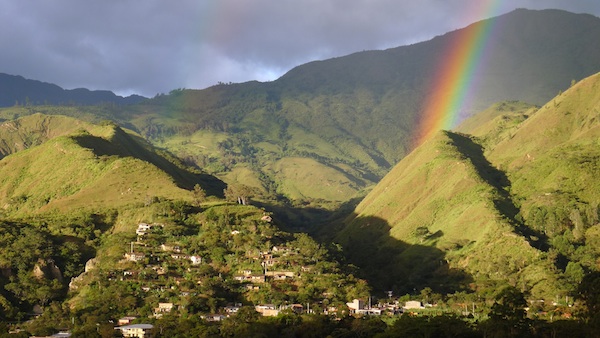
Nice rainbow view from our house in Vilcabamba Ecuador
7. Good climate. It’s not too hot or too cold year-round. You don’t need air-conditioning or heat and that means more fresh mountain air and negative ions for your health!
8. Easy to Get Residency. If you have $25,000 USD in an Ecuadorian bank or the equivalent value in property in Ecuador, you can apply for a resident visa and stay permanently. There seems to be a lots of hoops and paperwork to make this happen, but many people succeed and it’s certainly a reason why a lot of expats move to Ecuador.
9. Many Interesting Activities. Check the notice boards and ask around; you’ll quickly see that there are a lot of good workshops and activities being offered on everything from energy healing to women’s circles to essential oil lessons and much more.
Vilcabamba, Ecuador: Cons
1. Slow internet. This is true for all of Vilcabamba and can really be a problem if you work online (like me!).
2. Expensive Internet. We were shocked how much we paid for a few mice to spin us a connection….it was $84 USD per month!
3. Household items are Very Expensive. Things like pillows, sheets, kitchenware, plastic bins, shower curtains, etc. are extremely expensive in Ecuador. We were really shocked to see this because everyone told us how cheap it was! A plastic bucket could easily cost $5 or $6. That really adds up when you are buying for an entire home!
4. Superfoods and Supplements are Extremely Expensive. So much for the cheap cost of living! Once you get outside of the inexpensive rent, things can start to become expensive in Ecuador. While some superfoods and herbal supplements are available at the Juice Factory, they are really expensive, up to 3x the normal price. Your best bargain at the Juice Factory is the green juice shot made from wheatgrass, kale, parsley, fennel, celery and whatever other local organic greens are in season. Dennis, the owner of the Juice Factory, is a super-nice guy and very helpful by the way. It’s simply difficult to find a good source of organic raw nuts, seeds and dried basic raw food essentials.
5. Difficult to Find Work/Make Money. This is really a problem for a lot of gringos that don’t have an outside source of income. We saw many people trying to sell homemade raw food cookies, cakes and chocolates and hippie jewelry as a way to make money. The high cost of raw food ingredients makes the profit margin for food very low. Your best bet is to arrive with money or have a way to make money outside of Ecuador.
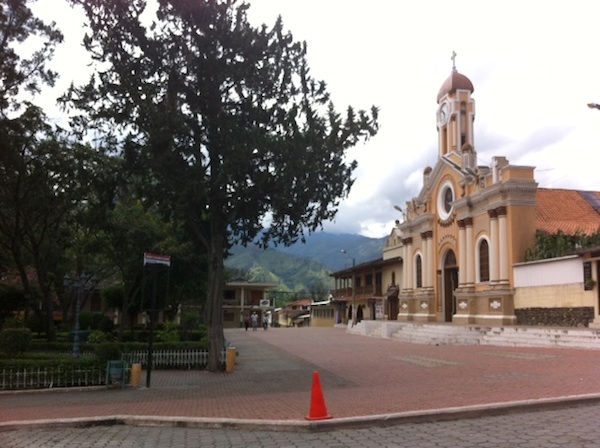
The town’s main square in Vilcabamba, Ecuador
6. Isolated. That can be a pro or a con depending on the individual! It’s a 1-hour drive to the nearest town, Loja, where you can find a large supermarket and the bigger shops. In Vilcabamba itself, there is really nothing but a few cafes and small shops selling essential items.
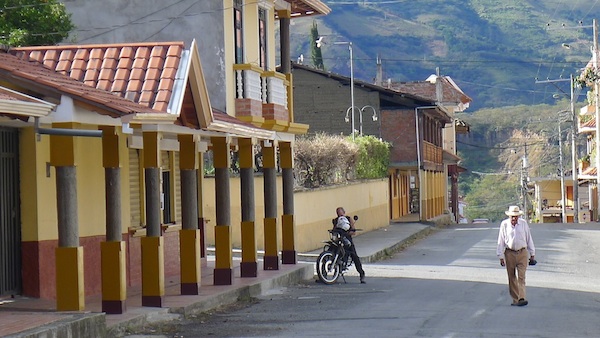
Not much to do in downtown Vilcabamba…it can be good but definitely isolating
7. Weird-vibes from certain Expat Locals can bring you down. As with any small town, there is a lot of gossip, rumors and even jealousy between gringos. This has a lot to do with #6 (isolated). If you’re prepared for this, you will be fine!
8. Increase in local crime, break-ins and robberies. This goes slightly against #5 of the Pros, but there I compare Ecuador to other countries in Central and South America. You are not likely to get robbed at gunpoint in Vilcabamba, and that is re-assuring. But, burglaries are on the rise. We heard of many break-ins while we were there; most occured while the residents were out to dinner and usually laptops, electronics and cash were stolen. Just before we arrived, there were at least 2 Western women who had been raped (in different incidents). It’s important to be careful. This is one of the main reasons why we chose to pay more money to live in a gated community. Definitely look at the security of your house before you decide to rent.
Vilcabamba can still be a great place to live and a positive experience as long as you stay street-smart and take advantage of all the good things it has to offer.
A lot of people ask me what I thought about Vilcabamba. Many young raw food, vegan and vegetarian couples and families consider moving there because of the ability to live relatively cheaply and still have access to organic food (most of the health-oriented people in Vilcabamba grow their own vegetables, fruits and greens). It’s not easy to describe my experience to others because everyone has different expectations when they travel to a new country to start a new life.

The house had a main living area, 2 separate bedrooms and an upstairs office/loft
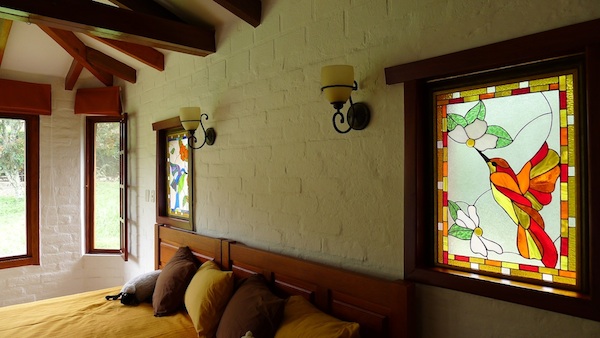
Quiet bedroom and lots of nature, ideal for a long water fast…this place was really a perfect detox retreat!
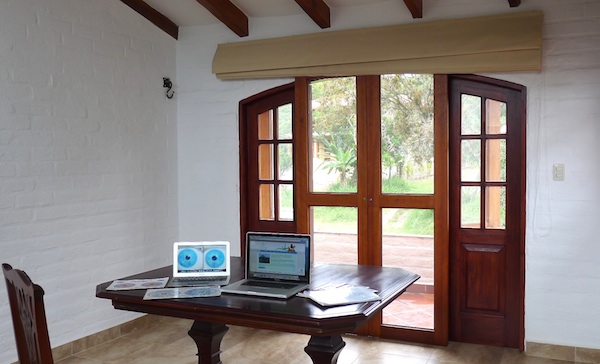
This was the upstairs loft which I used as an office. Great place for meditation or yoga as well!
I really liked Vilcabamba for the few months that I was there, but long-term, I don’t think it’s the place for me, at least not at this stage in my life. I feel a very strong need and pull to be in the mainstream still, to help people understand how to read food labels and look for hidden additives in food, to teach more about raw food and detox, and to show that you don’t need to live in the faraway mountains in order to be healthy. Maybe in a few more years this will change, maybe not. Stayed tuned for more updates, because you will know when I know!
One thing I would definitely recommend is to visit a place first and try to live there for at least 6 months before you seriously considering moving there permanently. Not everyone is able to handle the “mañana” approach in Ecuador (also known as the “mai pen rai” style in Thailand). When we take our Western mind with us, even when we want to “get away,” we may still expect the post office to deliver on time or for the store to open when it says it should or for the correct item to be ordered and delivered. Well, things just don’t happen like that in more relaxed places in the world.
If you decide to go, join the Vilcabamba Facebook page to search for houses to rent and ask any questions to the local expat community.
Top Pick for Vilcabamba
Be sure to check out Elena’s Raw Food Lunch in her private home, a monthly event offered directly from Elena and her husband Vladamir, 2 of the nicest people you will meet in all of Ecuador, and even in the world! Elena has a passion for raw food recipes like no other and every month she offers a new and unique raw food menu for lunch. It’s well worth it to enjoy her creations, and a great way to meet other local raw food people too.
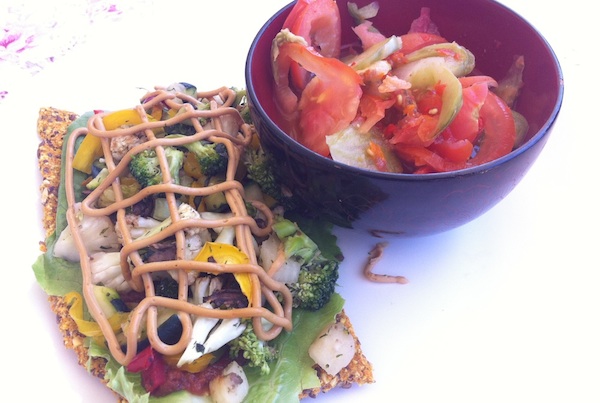
Elena’s Raw Food Lunch is amazing!! Here is her raw pizza with cashew “cheese”
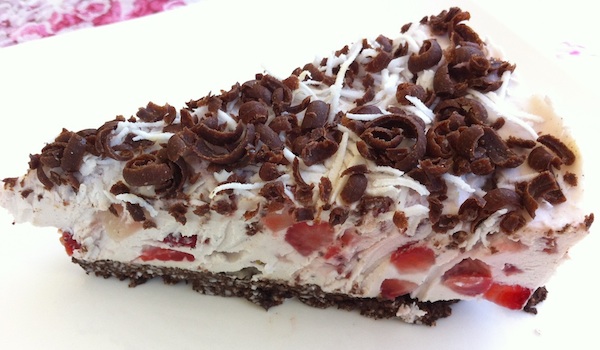
Elena’s raw cacao and coconut cake…this cake alone is a reason to visit Vilca!!
So is Vilcabamba a real Valley of Longevity? Well, maybe yes and maybe no. According to the book The Blue Zones: 9 Lessons for Living Longer by Dan Buettner, Vilcabamba did not make the cut for having a high number of centenarians (people who live over 100) because they don’t have the proper documentation to verify birth records for age verification. Personally, I didn’t see that many healthy old Ecuadorians. Sadly, many of the locals appeared to be overweight and more on the unhealthy side of life.

Beautiful mountains and vistas in Vilcabamba, Ecuador
A word of warning about the salt in Vilcabamba and all of Ecuador/South America for that matter: There is a non-caking agent in the salt called Yellow Prussiate of Soda (YPS) or E535 or 535. This chemical additive can cause an allergic reaction in people resulting in an extremely itchy rash, restless sleep, hot flashes and irritability. I saw many expats in Vilcabamba suffering, especially with rashes. Salt is used in all restaurants (including “healthy” restaurants) contains this additive. I found people very unaware and even ran into problems with one local expat who was selling his own “higher quality” salt that caused a terrible reaction for me; still he swore it was clean. Upon further questioning, he revealed that his product has never actually been tested. In short, do not trust homemade expat labels and check the ingredient list on all other salt. Fluoride is also added to salt in South America so most people do try to avoid buying it, but I did not meet one person who knew the dangers associated with YPS, in my opinion, the much more dangerous ingredient. Stick with Himalayan salt or buy the equivalent large pink salt from Bolivia which can be found in supermarkets in La Paz for $2 per kilo.
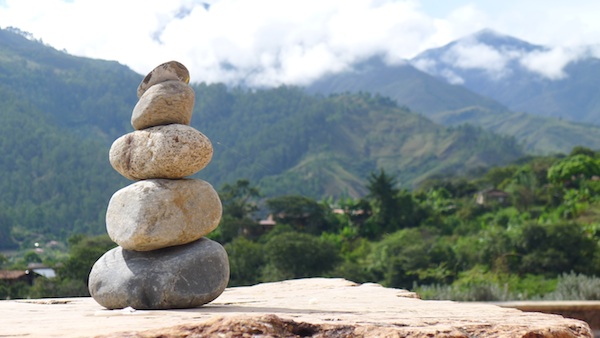
We have nice memories of Vilcabamba….thank you!!
Vilcabamba is definitely not for everyone, but it’s still be a good place for a raw food community, and I hope to see it thrive!
More on Traveling Raw:

Follow Jennifer